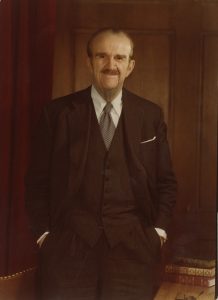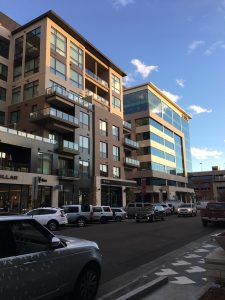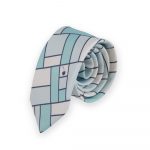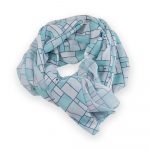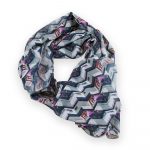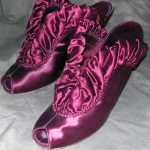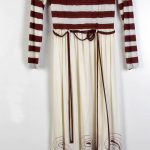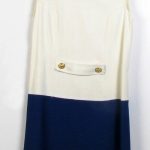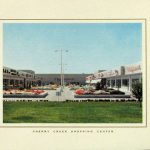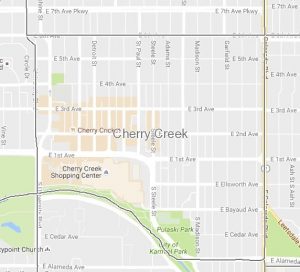
Cherry Creek is bounded by University and Colorado Boulevards, 6th, Alameda and the Cherry Creek.
“Where else in the city can you just walk out the door and walk to everything? There’s no where else, really. I walk to the grocery store, to the post office, to the library, to the dentist; there’s everything here. It’s so European.”
-Marianne Orkin, Cherry Creek neighbor
For many Denverites, “Cherry Creek” brings to mind images of the mall or the 16-block Cherry Creek North shopping district and evokes thoughts of shoppers browsing upscale brands or having their nails done, or maybe parking hassles and traffic backing up at the 4-way stops along 2nd or 3rd. But for about 6,000 people, Cherry Creek is home. Beginning as the small town of Harman in the 1800s where lots sold for $18.25 (roughly $465 in today’s dollars), Cherry Creek is now a neighborhood with a median home value of $841,500 that is experiencing some of the city’s most intense development. A beautiful tree-filled residential area with easy access to a myriad of shops, restaurants and services, it’s not hard to see why people love living in Cherry Creek.
A Brief History of the Cherry Creek Neighborhood
By Laura Ruttum Senturia
Library Director, Stephen H. Hart Library at History Colorado
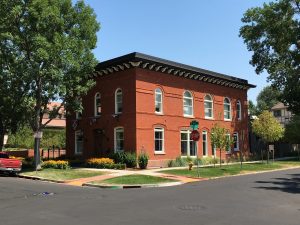
The Harman Town Hall is now a private residence. Image: Tara Bardeen
Shoppers in Cherry Creek North may have noticed a peculiar building at the corner of 4th and St. Paul: a private house that bears a plaque inscribed “Harman Town Hall.” Standing in the middle of the Cherry Creek North neighborhood as it does, it’s sure to have caused many to pause and wonder what it could possibly be. Was there a town named Harman?
As late as 1882, the area of Denver now known as Cherry Creek was sparsely populated, and certainly did not resemble the bustling community it is today. Beginning that year, much of the empty plain in the area was developed into a farm on “Harman’s Subdivision,” owned by lawyer and onetime judge Edwin P. Harman, originally of Mississippi, and his wife Lou. An interesting aside about Mr. Harman: in addition to founding a town and serving a community’s legal needs, he also fought in the Confederate infantry during the Civil War. Harman was wounded on three separate occasions, and was reported to carry several bullets in his body until his death and burial at Fairmont Cemetery in 1909.

A real estate ad for the Harman subdivision that was published in the Denver Republican newspaper in 1882. Image courtesy Stephen H. Hart Library & Research Center, History Colorado
Mr. Harman seems to have intentionally engaged in city development from the very beginning: he listed lots on his subdivision for public sale the same year he filed his 1882 property purchase. A community quickly grew up around his farm, and in 1886 it was incorporated as its own town bounded by York Street (now University), Carson Street (now 6th Avenue), Cherry Street (now Colorado Boulevard), and Sumner Street (now 2nd Avenue). Edwin Harman continued to live in the town named for him, and would go on to serve for several years as town attorney, for a salary of $150 annually.
The Town of Harman had its own separate street names (a few listed above), its own post office (3rd & Detroit), grade school (4th & Columbine), two churches (Congregationalist and Catholic), stables (2nd and Steele), and eventually its own streetcar connecting it to Denver (3rd & Detroit). It had its own mayor, the first being James Motley of Switzerland, who had come to Colorado in 1860 and fought in the Third Colorado Cavalry during the Civil War era.
Harman also had its own school, originally simply called the “Harman School,” that met in a two-story wood frame building until it caught fire in 1883. The new school, wisely made of brick this time, opened in 1885 and served the town of Harman and quite a number of their neighbors (between Gilpin and Dexter, and from 9th down to Alameda). The school had a team of teachers, several classrooms, a gym, and a library that was soon expanded to a public reading room. The school also served as a sort of community center, hosting both city council meetings and church gatherings until the Town Hall and two churches could be built. Interestingly, that 1885 building served nearly a century’s worth of children, until it was demolished in favor of the current Bromwell School building in 1976!
The school continued to go by the Harman name until 1906, when it was renamed “Bromwell” in honor of Henry P.H. Bromwell, a local politician (originally from Ohio and Illinois), who served in both the pre-statehood Territorial Council and later the Colorado legislature. Bromwell supported many progressive causes, including opposing slavery, strongly supporting women’s suffrage in Colorado, and advocating for universal free education. As a result, he took a great interest in the schools of his adopted home of Denver, including serving as school board district president in the 1870s. After his death in 1903, officials of the new City and County of Denver decided to name a school in his honor.
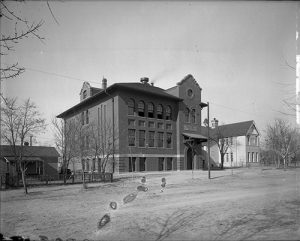
Bromwell School as it appeared in the 1930s. Image courtesy Stephen H. Hart Library & Research Center, History Colorado
Returning to discussion of the town itself, its proximity to the creek, and position on the Smoky Hill Trail also made it a strong contender for agriculture, sales, and trade. The trail itself traced a line along the creek from the Four Mile House to downtown Denver, and a section of it could still be seen at around 1st and Steele as late as the 1930s. Some referred to the area as “Cowtown,” due to cattle grazing down by the creek, and indeed several dairies existed in the Harman city limits. Agriculture was a strong element of the neighborhood as late as the 1930s, when there were no fewer than eight greenhouses in this small neighborhood (only one remains today, but will soon disappear to make way for a new development at 2nd and Garfield)!
So that mysterious building at 4th and St. Paul was just what it says it is: the original Harman Town Hall, built in 1891. The Hall hosted meetings, dinners, and dances (party rentals going for $10), but served in that capacity for only a short time. The town was swallowed up and annexed by Denver in 1895. Interestingly, Harman’s fate could have been different: their 1894 vote on annexation, the town’s second vote after the previous had failed, resulted in 57 votes for annexation and 55 against. Despite the small margin of difference, a vote to join Denver was a vote to join, and Harman and the Town Hall lost their original identity. Over the years after joining Denver, the Town Hall building served as a Masonic lodge and was later sold and converted to a private home, as it remains today.
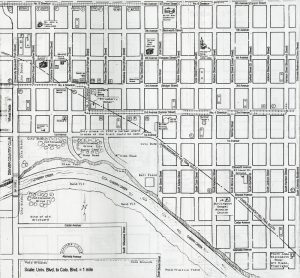
A map of the Harman Town area showing the location of shops and transit lines circa 1930. Image: “Harman and Its People: Project of the Harman Neighborhood Reunion Group,” compiled by Henry Johns, 1992
Following annexation, and with the passing of time and short memories, the “Town of Harman” ceased to be referenced as such. Denverites subsumed the town under a new neighborhood moniker based on the creek flowing nearby, just downhill and south from town.
This new neighborhood of “Cherry Creek” was nearly completely plotted by the 1920s, with sidewalks, alleys, curbs, sewers, and the like laid out around new homes. The area also had many empty lots—great fun for neighborhood kids!—which would remain that way through the construction stagnation of the Great Depression and the end of World War II. As far as commercial activity goes, by the 1930s there were shops along the northern part of the neighborhood on 6th Avenue, towards the bottom of the neighborhood along 3rd Avenue, and along the trolley line on Detroit.
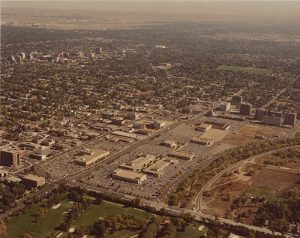
An undated aerial photo showing the Cherry Creek Shopping Center and surrounding area. Image courtesy Stephen H. Hart Library & Research Center, History Colorado
Thus far we haven’t covered the area where the Cherry Creek mall now stands, and for very good reason. Looking at the geography of the area prior to settlement, where the mall now stands would have looked very different back then. To start, while the creek flows quietly and unobtrusively along behind the mall today, it was responsible for much more than just the neighborhood name: the creek shaped the nearby land through its raging might. Yes, raging might. The seemingly small, quiet creek was notorious for creating havoc every few years, beginning with the massive Denver flood of 1864 that wiped out much of the city.
Frequent floods were a problem for early Denver, and the area we’re examining ended up soggy as much as did our downtown. Much of Cherry Creek (the neighborhood) was originally in a flood plain of the creek itself, and had over time been carved much lower and closer to the water than it is today. Harman, and the Cherry Creek neighborhood were uphill from the creek, above a cottonwood-filled gully section called “the Grove” (see map above). Just south of the Grove there was also an area locals referred to as the “sand pits,” essentially an alluvial plain of sand deposited by the creek, with easy access to a clear pool of creek water. Neighborhood kids would swim, fish, pan for gold, and do pretty much any activity imaginative kids dream up to fill the summer days.
Cherry trees and cottonwoods down near the water certainly sound idyllic, but the Grove area also served as a dumping ground for garbage until the 1940s, as well as a campsite for itinerants and others the citizens of the neighborhood found troublesome. Between the semi-frequent flooding, the dump, and the undesirable activities going on in the Grove, the creek and its banks were seen as a problem. In the nineteen-teens and again in the 1930s the city tamed the Cherry Creek with concrete walls, but did not fill in the Grove until several decades later.
An eventual infill project created land closer in altitude to the residential district, with a slight upward slope from the creek towards town. This new plain of imported dirt allowed the city to reroute 1st Avenue between University and Steele (where 1st is now located originally dropped off after the Denver Country Club, where the ground dipped down to form the Grove, and did not pick up again until Steele). The new land also allowed for the Cherry Creek neighborhood to expand onto the plain. Overall, the filled-in area in question corresponds with today’s mall and 1st Avenue. So when you think about the funny little jogs that 1st does on its way east, that’s likely due to the fact that it lies on ground created much later than the rest of the neighborhood. The city had to squeeze the new street onto an existing framework. And when you think about the irony of building an upscale mall over the infill of a town dump, one might say the mall was an improvement in more ways than just sartorially.
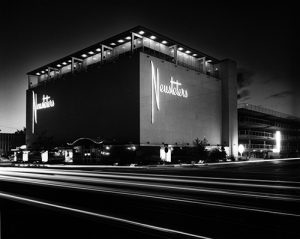
An undated photograph of Neusteters Department Store in Cherry Creek. Image courtesy Stephen H. Hart Library & Research Center, History Colorado
The Cherry Creek Mall as we know it today, of course, is also a more recent development, and an extension of the growth that has had ongoing effects on the residential sections of Cherry Creek for nearly 100 years. In 1925, Chicago-born architect Temple Buell purchased the land formerly known as the Grove, and then engaged in 24 years of Denver’s favorite neighborhood sport of zoning disputes and political maneuvering. In 1949, he was finally able to break ground for the Cherry Creek Shopping Center on the western end of the property that now houses Macy’s, the Container Store, and Elway’s. This development—an open-air pedestrian mall at a time when free-standing department stores and small town shops were the national norm—was completely new to Denver, and indeed unique across the United States. The shopping center opened its doors in 1950, eventually featuring a Denver Dry Goods, a Baur’s Restaurant location, Walgreens, and a Neusteter’s department store, among other shops. The mall, with a new Sears across the street, and both a Safeway grocery store and movie theater further east, established Cherry Creek as a new destination hub for shoppers.
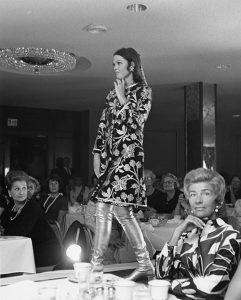
A fashion show at Neusteters. Image courtesy Stephen H. Hart Library & Research Center, History Colorado
The original shopping center served the retail needs of Denverites for 40 years, until it was essentially superseded by the current Cherry Creek Mall in 1990. Prior to development of the new mall, neighbors again protested about retail expansion, with many fearing a huge new mall would bring in such a crush of shoppers, and their cars, that it would destroy the existing quaint character of the neighborhood. The new mall in practice did bring in a lot of national retail chains hitherto unseen in Denver, thus sucking oxygen out of the room for the small, locally-owned shops of Cherry Creek North. Many shops struggled for some time after the mall’s launch. Despite common perceptions, however, the Cherry Creek Business Improvement District today cites that 70% of businesses in the neighborhood are local.
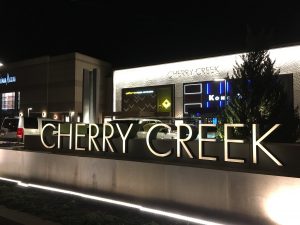
Today’s Cherry Creek Mall features more than 160 shops, including 40 stores exclusive to the area such as Neiman Marcus, Tiffany & Co., Burberry, Louis Vuitton, David Yurman, and Tory Burch. Image: Tara Bardeen
The other much-feared development Cherry Creekers feared—the traffic—did arrive, making what had previously been a sleepy neighborhood into a “pass through” for Denver drivers heading to the mall. The increased number of visitors also brought a parking problem, which the city has largely solved by designating a parking sticker system that favors neighborhood residents. Despite these challenging changes, however, the mall did not destroy the neighborhood-ness of the area, which managed to survive mostly intact.
Development in the area has been an ongoing trend, however, with many of the original small homes torn down and replaced by condos over the past few decades. Cherry Creek North residents once again fear side-effects from the more recent boom of restaurants and shops, demolition and building of luxury high rises that we see today. Those who love the neighborhood are fearful that Cherry Creek won’t be able to preserve its small town community feel, that the neighborhood’s character will be completely erased by Denver’s commercial march through history. The area has indeed seen many changes over time: going from a farm with a creek and a grove, to a small town, to a neighborhood, and eventually to a retail district, all over the course of 130 years. Knowing that Cherry Creek has fought excessive development for nearly a century, odds are good the neighborhood will continue to hold its own.
Wrap Cherry Creek Around Your Neck and Take It Everywhere
“We were inspired by the modern architecture of the Cherry Creek North shopping district. Glassy surfaces and hard lines are common motifs in the new construction found in the area in addition to the iconic cherry that has been associated with the neighborhood for years.” – Almenia and Allison, designers at Knotty Tie
Get your own Cherry Creek-inspired bowtie, necktie or scarf here: Knotty Tie Co.
Save 20% on your order with code GOPLAYDENVER.
Interview with a Neighbor: Marianne Orkin (Near 4th & St. Paul)

10 years.
What drew you to this neighborhood?
Ever since I came here 30 years ago from London (after growing up in Sweden), I have wanted to live in Cherry Creek. When we first moved to Denver, we lived by DU, near McWilliam’s Park (Milwaukee and Yale), and we lived there a long time, but the only place I wanted to live was Cherry Creek because it reminds me of Europe. You walk out your front door and don’t have to take the car. So, anyway, 10 years ago we decided to sell the house and we moved into this neighborhood. It’s the only neighborhood I really wanted in the whole of Denver.
Before I lived here, I used to come and walk in the spring and go up and down St. Paul admiring the tulips. When we looked here in 2007, there weren’t that many houses on the market and my husband said, “I don’t want to spend that kind of money,” but you pay for the neighborhood, for the convenience and walkability. Now that we live here, my husband and I just love it.
Where else in the city can you just walk out the door and walk to everything? There’s no where else, really. I walk to the grocery store, to the post office, to the library, to the dentist; there’s everything here. It’s so European.
There are some lovely, friendly neighborhoods elsewhere, and I was surprised by how friendly this neighborhood is. It’s really friendly. But sometimes I’d like to have people outside a little more. It seems like everyone comes into their garage and no one is out working in their yards because they hire someone to do it. There aren’t a lot of porches here.
How would you describe the Cherry Creek neighborhood in 3-5 adjectives?
Pedestrian, convenient, upscale, friendly
How would you spend a perfect day in Cherry Creek?
I hardly ever go for breakfast out, that seems like an American thing to do. My husband and I don’t often go out for breakfast, we’d rather go out for lunch or dinner, so breakfast at home. Occasionally, I might meet someone for breakfast, and I used to love So Perfect Eats (formerly on Fillmore between 2nd & 3rd); it was a lovely little place. It’s a shame that places like that are disappearing from our neighborhood. If I were going out for lunch, I like the Crepe place (Crepes ‘n’ Crepes, 3rd between Detroit & Fillmore).
So, a perfect day would also include walking and biking. I don’t do my biking around here so much, but on the trail down to REI. I go through Denver Country Club and catch the trail across Speer. And then for walking, we have a walking club that meets every Tuesday morning and then we walk up 7th Avenue and around Cheesman Park and back.
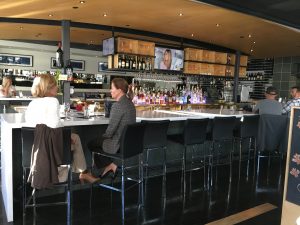
Cucina Colore opened in 1994 and offers a modern take on Italian cuisine, plus happy hour drink specials weekdays 4p – 6p. Image: Tara Bardeen
I belong to the Cherry Creek Athletic Club (Cherry & Virginia), so I might also go there to exercise. I might meet up with some friends for lunch or drinks. I might work on planning a trip. I like to go out for Happy Hour. Cucina Colore and North have good happy hours. I think sometimes it’s nice to meet up with a girlfriend for a happy hour at 4-4:30 and have a drink and chat because when you go out as couples, it’s a different conversation, isn’t it?
For dinner we might go to Cucina Colore (3rd & St. Paul), Sweet Ginger (3rd between Clayton & Detroit), Piatti (2nd & St. Paul), Hillstone (3rd & Josephine) or North (2nd & Clayton).
What might surprise people about your neighborhood?
What I say to most people, and everyone may not feel like I do, but I tell people how friendly it is and how much activity there is in Cherry Creek North. We have neighbors who moved in from Evergreen where they had lived for 35 years and now they live just up on Steele Street. They’re retired now and they have said how they can not believe how many people they have met here. They have an amazing social life here. We also have so many social activities with the neighborhood association.
What are some of the community hubs of your neighborhood?
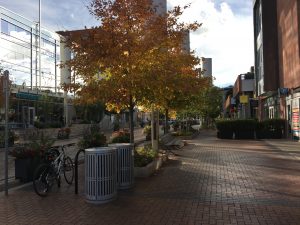
Fillmore Street between 1st and 2nd. Image: Tara Bardeen
I would say the Starbucks (2nd & Fillmore), Whole Foods (1st & University), the library (Ross-Cherry Creek at 3rd and Milwaukee) and all the Cherry Creek North Neighborhood Association social groups (there are more than 50 CCNA social groups that include walking, books, cinema, cribbage, and foreign languages among others).
Where are your favorite places to walk?
My brother-in-law will say to me, “Are you going for the nature walk today or the shopping walk?” As I often say to my friends, when I go down to the Whole Foods, I can never get down there fast and come back because I bump into people and then I stand and chat and then it takes me an hour and half to two hours!
My exercise walk is along 7th Avenue and through Cheesman park.
Live in Cherry Creek? We’d love to know what your perfect day would include! Email us: [email protected]
Intriguing Artifacts Related to the History of Cherry Creek
Did you know? The Stephen H. Hart Library & Research Center at History Colorado (12th & Broadway) also houses artifacts that are viewable by the public. This means you can inspect actual historical objects while at the library. You don’t need an appointment to visit the library, just walk in. It’s free and the librarians are friendly and helpful! You can also check out some of their collection online: h-co.org/collections
- Neusteters slippers
- A dress designed by Terry Mehtz and sold at Neusteters
- A Neusteters brand dress
- A plate used at one of the Baur’s restaurants in Denver
- A Christmas card depicting the Cherry Creek Shopping Center
Images: All images, unless otherwise noted, are courtesy Stephen H. Hart Library & Research Center, History Colorado.
Sources: “1001 Colorado Place Names,” by Maxine Benson; “Denver Streets: Names, Numbers, Locations, Logic,” by Phil Goldstein; “Minutes, Ordinances, and Miscellaneous Data of Towns Annexed to Denver,” Civil Works Association Project; “Architects of Colorado: Biographical Sketch of Temple Buell,” From the Colorado Office of Archaeology and Historic Preservation; “Harman and Its People: Project of the Harman Neighborhood Reunion Group,” compiled by Henry Johns, 1992; “The Town of Harman. Reproduced from a booklet published for Bromwell’s Bicentennial Reunion. May 2nd, 1976,” at http://bromwell.dpsk12.org/about/history/the-town-of-harman/; www.zillow.com and www.shopcherrycreek.com
